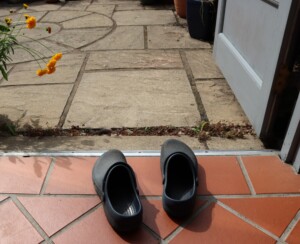
OK, so ‘an old pairs of shoes’ is not the most exciting title for a blog post – but the Alexander Technique is, after all, centred on the everyday. Through it we can turn the often mundane nature of daily life into something that’s interesting and fulfilling. Even in relation to wearing an old pair of shoes!
A few days ago I was walking through our back garden, while carrying a box that obscured some of my view of where I was going. The layout of my garden is very familiar to me but that day I made a mistake estimating which bit was path and which bit was bed, and I turned over on my ankle. As it was happening I managed not to panic and stiffen; I then took time to check how I was – nothing at all serious, just a very slight sprain. Rather than carrying on with what I was in the middle of doing, I went off for an Alexander lie-down, putting something cool over my ankle. It did hurt a little bit again later in the day but all was completely back to normal by the next morning.
After it happened I thought, ‘Why do I wear those old slip-ons in the garden when all my other shoes are barefoot?’ If I’d been wearing barefoot shoes, it’s likely I would have been able to allow my foot to adjust and roll gently, as there would have been no hard shoe edge to trip over awkwardly.* But, of course, wearing slip-ons compared with other shoes saves a couple of seconds putting them on, and we all tend to go for the ‘quick and easy’ option, rather than taking more care over how we do things. It reflects a general approach to life that FM Alexander called ‘end-gaining’ – we tend to over-focus on what we want to achieve and just do it, without much or any consideration to the process of achieving it.
Today I was about to nip out to pick some lettuce for lunch and saw that my partner’s gardening shoes were right in front of the door. I noticed my first thought which was something along the lines of ‘It would lazy to put those on, especially as they’re a much bigger shoe size than mine, so it would be even more awkward and also foolish given what happened the other day.’
But then I paused and had another thought – am I needlessly limiting myself if I routinely avoid anything that could perhaps be a little bit challenging? Instead, why don’t I enjoy wearing my 2-sizes-too-big partner’s shoes and the opportunity this offers for added awareness and presence to take care of myself? So I did put on the shoes, I just did it without an end-gaining attitude. And going forwards, I’ll aim to make it a conscious choice each time which shoes to put on.
This extremely mundane example made me reflect on how common it is for us to limit our choices based on previous adverse experiences. This is particularly true as we become older. Perhaps we have had a fall in the winter so we don’t go out if it might be icy, or we hurt our back when digging, so don’t do so much gardening anymore? We can’t help being influenced by our life’s experiences, it’s happening all the time in both positive and negative ways. When we’ve had an accident or injury, there will always be an underlying fear, subconscious or conscious, of a repeat. What we can do, however, is to use the awareness and skills that we develop through learning the Alexander Technique to give us the confidence to be able to navigate life as safely and effortlessly as we can. There’s also research to show that training in the Alexander Technique leads to improved balance and movement coordination, so we really can be better at looking after ourselves in any activity!
There are many things we do in daily life that are potentially hazardous (chopping vegetables, running down stairs, lifting something heavy etc). As I go about such activities, I’d rather not be anxious, nor the other extreme of being oblivious. Instead, I’d rather use the Alexander Technique to keep myself safe and be able to turn the mundane into something interesting.
* By the way, I’m not advocating that everyone should rush out and replace all their shoes with barefoot shoes – not least, they can take some getting used to if you’re new to them. My own experience is that they enable much more freedom of movement and better feedback. Relatedly, I used to play badminton and for years had worn the cheapest and flattest plimsolls. Then at one point I thought, shouldn’t I invest in some ‘proper’ badminton shoes? Bad decision! It’s the only time in over 20 years of playing that I had a significant injury – I went over on my ankle and ripped my Achilles’ tendon. Of course, I can’t be sure that I wouldn’t have injured myself so badly if I hadn’t been wearing shoes designed to ‘protect you’. However, there is anecdotal evidence, as well as now some research showing a greater incidence of injury with certain types of sports shoes – those with thick heels and soles, compared with flatter ones [1].
Reference: Vincent HK et al. Frontiers in Sport and Active Living 2024; 6: https://www.frontiersin.org/journals/sports-and-active-living/articles/10.3389/fspor.2024.1491486/full